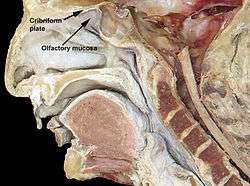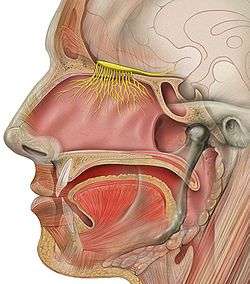Olfactory nerve
| Olfactory nerve | |
|---|---|
 Head bisection showing location of olfactory mucosa and cribriform plate. Olfactory nerves are too small to b e seen in a gross section. (Suarez, C.A. and Vilensky, J., All-in-One Anatomy Exam Review. Vol. 1 Back and Upper Limb) | |
 The Olfactory Nerve | |
| Details | |
| Identifiers | |
| Latin | nervus olfactorius |
| MeSH | A08.800.800.120.640 |
| TA |
A14.2.01.004 A14.2.01.005 |
| FMA | 46787 |
| Cranial nerves |
|---|
|
The olfactory nerve (Latin: nervus olfactorius) is typically considered the first cranial nerve, or simply CN I. It contains the afferent nerve fibers of the olfactory receptor neurons, transmitting nerve impulses about odors to the central nervous system, where they are perceived by the sense of smell (olfaction). Derived from the embryonic nasal placode, the olfactory nerve is somewhat unique among cranial nerves because it is capable of some regeneration if damaged. The olfactory nerve is sensory in nature and originates on the olfactory mucosa in the upper part of the nasal cavity.[1] From the olfactory mucosa, the nerve (actually many small nerve fascicles) travels up through the cribriform plate of the ethmoid bone to reach the surface of the brain. Here the fascicles enter the olfactory bulb and synapse there; from the bulbs (one on each side) the olfactory information is transmitted into the brain via the olfactory tract.[2] The fascicles of the olfactory nerve are not visible on a cadaver brain because they are severed upon removal.[3] :548
Structure
The specialized olfactory receptor neurons of the olfactory nerve are located in the olfactory mucosa of the upper parts of the nasal cavity. The olfactory nerves consist of a collection of many sensory nerve fibers that extend from the olfactory epithelium to the olfactory bulb, passing through the many openings of the cribriform plate of the ethmoid bone, a sieve-like structure.
The sense of smell (olfaction) arises from the stimulation of receptors by small molecules in inspired air of varying spatial, chemical, and electrical properties that reach the nasal epithelium in the nasal cavity during inhalation. These stimulants are transduced into electrical activity in the olfactory neurons, which then transmit these impulses to the olfactory bulb and from there to the rest of the central nervous system via the olfactory tract.
The olfactory nerve is the shortest of the twelve cranial nerves and, similar to the optic nerve, does not emanate from the brainstem.[2]
Function
The functional components of the olfactory nerve include SVA, special visceral afferent, which carries the modality of smell.
Clinical significance
Examination
Damage to this nerve impairs the sense of smell. To simply test the function of the olfactory nerve, one of the patient's nostrils is closed and a substance with a pungent odor (such as damp coffee essence) is placed under the open nostril. The test is then repeated on the other nostril. If the patient can smell the substance the patient’s olfactory nerve is likely functioning. There are olfactory testing packets in which strong odors are embedded into cards and the responses of the patient to each odor can be determined.[2]
Lesions
Lesions to the olfactory nerve can occur because of "blunt trauma", such as coup-contra-coup damage, meningitis, and tumors of the frontal lobe. They often lead to a reduced ability to taste and smell. However, lesions of the olfactory nerve do not lead to a reduced ability to sense pain from the nasal epithelium. This is because pain from the nasal epithelium is not carried to the central nervous system by the olfactory nerve; rather, it is carried to the central nervous system by the trigeminal nerve (cranial nerve V).
Aging and Olfaction
Decreases in the ability to smell is a normal consequence of human aging, and usually is more pronounced in men than in women. It is often unrecognized in patients except that they may note a decreased ability to taste (much of taste is actually based on reception of food odor). Some of this decrease results from repeated damage to the olfactory nerve receptors due likely to repeated upper respiratory infections. Patients with Alzheimer's disease almost always have an abnormal sense of smell when tested.[2]
See also
| Wikimedia Commons has media related to Olfactory nerve. |
Additional Images
- Olfactory nerve.Deep dissection.Inferior view.
External links
- cranialnerves at The Anatomy Lesson by Wesley Norman (Georgetown University) (I)
- Notes on Olfactory Nerve
Notes
- ↑ Mcgraw Hill's Anatomy and Physiology Revealed
- 1 2 3 4 Vilensky, Joel; Robertson, Wendy; Suarez-Quian, Carlos (2015). The Clinical Anatomy of the Cranial Nerves: The Nerves of "On Olympus Towering Top". Ames, Iowa: Wiley-Blackwell. ISBN 978-1118492017.
- ↑ Saladin, Kenneth. "The Cranial Nerves." Anatomy and Physiology: The Unity of Form and Function. 6th ed. New York City: Mcgraw-Hill, 2012. 548.